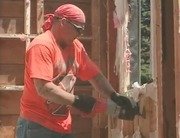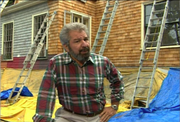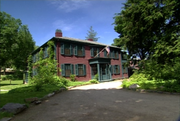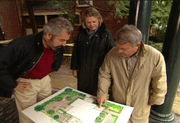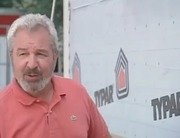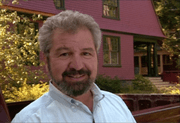we are in the Green Hill historic district in Brookline, Massachusetts just outside of Boston, truly one of the most beautiful towns in America.
We're visiting the Frederick Law Olmsted Historic Site, which is now managed by the National Park Service.
Olmsted was a landscape architect in the nineteenth century.
You may have not heard of him, but you have certainly heard of Central Park in New York City.
And maybe the Emerald Necklace Park System here in Boston, and the Chicago lake front.
And countless other cityscapes, that were created by Frederick Law Olmsted and his architectural practice.
Let's get together with our friend Lauren Meier, who is the historical architect here, right?
Historical landscape architect.
Landscape architect, exactly.
And although we're here to talk about landscape architecture, there is a beautiful example of early Federal period architecture right behind us, tell me a little about the house.
Well, the house was built originally around 1810, and when Olmsted arrived here in 1883, he immediatly began making changes both to the landscape and the structure.
So he bought it f rom the original family.
That's correct.
And as I understand it, he tripled the size of it and created a landscape architecture practice right here.
That's right.
It was really the first full scale, professional landscape architectural office in America .
And I know because I lived in this neighborhood up until just a few years ago that this was not just a shrine to landscape architecture, but there was also a treasure trove of original drawings and manuscripts and photographs and records kept here, right?
That's correct.
In fact when the national park's service arrived in 1980 there were a 150 thousand plans and drawings that represented the design work on about a five thousand design projects in 50, in 45 states nationwide.
Amazing.
Laura, as I understand, much of the work that actually goes on here today is preservation of these documents, is that right?
That's correct.
In fact national park service is undergoing a comprehensive stabilization program To make the drawing collection available to researchers who are working in Onstead in nationwide.
Yeah, it's got to be the most important collection of its kind in the country.
I think That's true.
The process includes very interesting, it includes surface cleaning, humidification flattening and mending using natural materials.
Wonderful.
Now let's talk about the landscape that we look at here, because when I think of Victorian landscape design, I think of very clipped and ordered gardens.
And here, it's kind of like looking at the New England jungle, if you will.
This is the tree growing out of these rocks.
What's the story?
Well, this is a very typical of Onsteads work.
He planted this hemlock and accentuated the landscape around this natural, I've cropping a rocks by putting stone if we right here.
Okay so this tree has been here for a century and he planted it.
That's correct.
Did he alter the topography in this area to create this drive?
This was one of the first major moves that Onstead did when he arrived.
He first To move the entrance from around the corner to this location.
To this side of the house.
That's right.
Yeah.
And filled this area which had historically had a natural slope to look to it, to create the dry.
So that's how they created this, this hollow down here as well, right?
That's correct.
I don't mean to offend but this doesn't look terrific.
Well, what you see is a landscape restoration in process.
We had removed a lot of volunteer growth that happened in the last century and are in the process of replacing missing plants.
So we do have some of the plants that were what here doing on this time?
I notice vines running all over the place in top to this stone.
That is something as typical of late 19th century planting?
Well certainly in particular Onster's work.
He used to find to cover every thing.They
covered the fence, they covered this terrific out roxbury.
Yeah this it's all roxbury pudding stone with, with, is that you them on Euyonomous Fortunia?
Yes, it's called Euyonomous Fortunia.
Yes, the creeping winds winter creeper.
Marvelous.
Now the really beautiful part of the property is on the other side of the house I believe.
That's true.
Lauren, is any of the plant material here surviving from Olmsted's day?
Yes, most of what you see here today was here.
What's this, for example?
This is a yew, Taxus cuspidata.
My gosh!
We are used to seeing yew bushes in the nursery and you can create hedges with them.
But this one is actually a gorgeous tree, isn't it?
Yes.
And this flowering shrub over here.
This is mock orange.
Yes, sure.
It's fabulous.
It's so fragrant.
And this is a very typical plant used by the Victorians, isn't it?
That's correct and you can buy it today.
What's this tree overhead?
This is a cucumber magnolia, and this is a tremendous specimen.
This is a very historic tree.
It's got to be fifty feet height.
It is wonderful.
And then you have a path running right here.
What do you call this?
This is a Euonyms find in a local nursery, but this is a very old specimen.
So this has probably been here for a century.
Yeah.
That's true.
And this is magnificent.
And what you call this tree?
This is a native mountain laurel, it's Kalmia latifolia.
I'm used to thinking of it as a shrub and this is actually almost a tree here, isn't it?
Well, they're very old specimen.
But this is something that you can go out and buy today at a home center, right?
That's correct.
They're commercially available.
Gosh, this almost looks like a Bonsai garden here.
Doesn't it not?
This is a terrific.
This is part of the rock garden and you can see the native Roxbury puddingstone again, and this natural moss.
Now, what are some of the real important specimens here.
Well our most important plant on the entire property is this magnificent American Elm.
Lauren, the American elm is an endangered species, isn't it?
That's correct.
American Elms are disappearing from the American landscape because of the Dutch Elm Disease.
This is a spectacular specimen.
So this has been here since Fredrick Law Olmsted's day?
in fact, it was here when he arrived, and he used it as an organizing principle around which the entire landscape was created.
Now, haven't they created a hybrid, or something, out of this tree that is resistant to the disease?
Yes, it's called Liberty Elm.
But we're very interested in the original species which is Ulmus americana.
And so you're propagating it?
That's right.
The Arnold Arboretum of Harvard University has propagated this tree, so that we can replace it, in kind, with an exact genetic replacement.
Maybe some day we can all get seedlings.
Sounds great.
Now, the Center is open to the public on weekends throughout the year?
That's correct.
You can visit the Olmsted National Historic Site on Fridays, Saturdays and Sundays year round, and other times if you call ahead.
On Warren Street in Brookline.
Thanks for the tour.
Thank you.
We've got to break for messages, don't go away.

